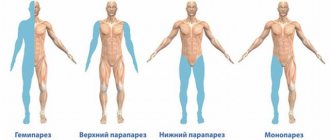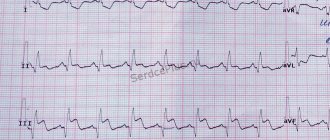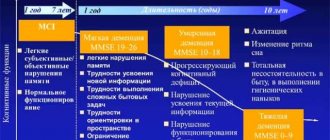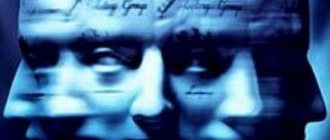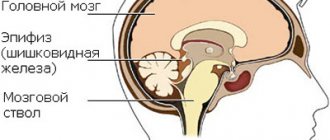Broca's and Wernicke's centers
Broca's center
- a section of the cerebral cortex, named after the French anthropologist and surgeon Paul Broca, who discovered it in 1865 [1], located in the posteroinferior part of the third frontal gyrus of the left hemisphere (in right-handers), the work of which ensures the motor organization of speech and is mainly associated with phonological and syntactic codifications. It is a kinetic-motor verbal analyzer, which primarily processes proprioceptive information. When this center is damaged, so-called Broca's aphasia (anarthric syndrome) occurs, which is characterized by the inability to combine individual speech movements into a single speech act.
An article published in October 2012, containing the results of research conducted at MIT under the direction of Nancy Kanwisher, states that Broca's area is divided into two areas, one of which is part of the neural networks of speech production, and the second of which is part of the networks associated with speech production. with mathematical problem solving and memorization.[2][3]
Speech as a product of brain activity
There is an opinion that conversation is a psychological process, since the average person simply needs to communicate with someone, even if it is an animal.
He needs to know that he is being listened to. For this reason, people who are afraid of being alone talk to themselves - this is how they get the impression of mutual dialogue. Speech is a way of understanding the world around us, allowing us to feel part of it. Broca's area, already mentioned above, makes it possible for us to listen, understand and respond to the interlocutor's remarks. But this is not always enough for an adequate conversation, since in addition to understanding, you also need a well-trained voice, vocabulary, the ability to accurately convey your thoughts, and a whole series of other requirements.
Background
In medical practice, the first experiments to identify the areas of the brain responsible for speech were made at the beginning of the 19th century. In the mid-1860s, French anthropologist and surgeon Paul Brocq published the results of his research, which stated that the area of the cortex responsible for speech is located in the posterior lower region of the left hemisphere. This applies to lefties.
The result was obtained thanks to the doctor's observation. He noticed that people who had suffered a right hemisphere stroke did not have speech defects or disorders. In those whose left hemisphere was damaged due to a stroke, such anomalies were detected, and quite pronounced.
This area of the brain is called Broca's area. Let's look at this area in detail: its location and purpose according to a French specialist, and then we will resort to the results of scientists from New York Medical University, whose experiments confirm the lack of knowledge of the organ and actually put an end to more than a century and a half of medicine and science’s understanding of the speech center in the head brain.
Speech problems after a stroke
After a circulatory disorder in the brain - a stroke, most patients cannot pronounce a clear sentence, and sometimes even a phrase. It is not a fact that in such a state they can even think rationally and compose these sentences in their minds. Science has identified two groups of speech disorders in people after a stroke:
- aphasia – when the cerebral cortex, which is responsible for speech and a whole list of other mental and physiological processes, suffers;
- dysarthria is a condition caused by the innervation of the muscles of the speech apparatus located in the nasopharynx.
We see that the idea expressed at the beginning of the article that a person knows practically nothing about the brain is confirmed. For a century and a half, people have recognized that Broca's center is located in the left hemisphere, its main function is speech production, but recently it was discovered that no single brain center fully takes on all these functions. Soon textbooks will have to be written anew.
- Broc's center is responsible for
Broca's area
This great man devoted his entire life to studying the human brain. During his lifetime, he joked with himself, saying that he loved his own clinic a little less than the laboratory in which he spent all his free time. He was an anthropologist, a neurosurgeon, and an ethnographer. Broca's area was discovered by a surgeon while treating two elderly men in his hospital. One of them had been ill for more than twenty years: lack of speech, paralysis of the right arm and leg - this is just a small part of the lesions that were noticed by Paul.
The second patient arrived at the clinic with a hip fracture; as it later turned out, a few years ago the man had a seizure, due to which he lost the ability to speak. Subsequently, the poor fellow could only pronounce five words from his native French language.
Today, surgeons would immediately diagnose a lesion in Broca’s area, but in those days (early 19th century) they had not even heard of such a part of the brain, and therefore did not try to treat it. But Paul immediately realized that the left hemisphere of the brain is responsible for our speech. In this regard, numerous studies have been conducted that have shown the correctness of the researcher’s arguments.
Have you ever wondered where the area responsible for the ability to speak is located? Broca's area is located in the posterior inferior part of the third frontal gyrus of the left hemisphere in people who write with their right hand. For left-handed people the opposite is true.
With the help of this center we can talk, or rather, construct sentences correctly. For example, young children do not always express their thoughts clearly, since Broca's area is not as developed in them as in adults due to little experience of communication. This part of the brain is presented in the form of a kind of analyzer, which primarily perceives useful information and reproduces it.
Practice and only practice! You need to monitor your speech and pay attention to your mistakes as often as possible. Talking to yourself if you have problems with speech will also not be superfluous. Reading books and listening to famous classics can also help. But still, if you feel that the problem has become widespread, you should contact a specialist to prevent more serious diseases. Modern medicine offers many drugs and procedures that will prevent the development of aphasia of Broca's and Wernicke's areas.
The center of speech turned out to be heterogeneous • Science news
As you know, articulate speech is formed mainly in a special area of the brain called Broca's area. German scientists carried out a detailed anatomy of this zone and discovered significant cytological and functional heterogeneity within this zone.
The study was able to detect left-hemispheric asymmetry in the distribution of the muscarinic receptor, which is associated with the level of intelligence in humans.
This study opens up broad prospects for a more detailed analysis of the origin and evolution of the linguistic abilities of Homo sapiens.
The emergence and evolution of articulate speech are associated with the specialization of special areas of the brain, one of the most significant of which is Broca's area. Broca's area occupies the posterior part of the inferior frontal gyrus and innervates the muscles associated with speech production.
In humans, it is clearly asymmetrical: in 94% of right-handers, speech is organized due to the functioning of the left hemisphere - the size and configuration of Broca's area in the left hemisphere differs from its right-hemisphere reflection.
It is interesting to note that different areas of Broca's area are enlarged differently in men and women, as recently shown by a German-Dutch team of neurophysiologists.
Broca's area (rather, its analogues) has been studied in various primates, and recently works have appeared that have proven left-hemispheric asymmetry in monkeys. Thus, William D. Hopkins tried to prove that the left hemisphere of chimpanzees, like humans, is larger than the right.
In other words, the generalized function of this region is communicative signaling, and it was developed in the common ancestor of chimpanzees and humans.
In 2009, Hopkins, co-authored with Chet C. Sherwood, published a new study in which he somewhat rethought his previous results. Using anatomical material, these scientists carefully measured the area and volume of Broca's area in chimpanzees and counted the neurons included in this area. AND…
asymmetry in the anatomical structure of the brain in monkeys has not been confirmed! True, some monkeys showed a 10% increase in the volume and number of neurons in the left hemisphere compared to the right, but approximately the same proportion of monkeys were characterized by the opposite ratio - an increase in the right hemisphere compared to the left.
The anatomical asymmetry of Broca's area in monkeys appears to be quite variable. Probably, as scientists have suggested, the point here is not so much in anatomy, but in the functional specificity of the right and left hemispheres, and it is formed due to differences in the neural connections of this part of the brain with others.
It must be emphasized, however, that this painstaking work resulted in precise quantitative comparisons between Broca's area in humans and chimpanzees. They speak unconditionally about the “humanity” of Broca's area.
The human brain is 3.6 times larger (on average) than the chimpanzee brain, and Broca's left hemisphere area, defined by anatomical features, is 6.0–6.6 times larger than the corresponding area in monkeys. Isn’t this proof that the specialization of this particular area endowed Homo sapiens with wisdom?
https://www.youtube.com/watch?v=eNKZHMAI1MU\u0026list=PLRe-nkTMm0xu8a6crwDGfeIiPl97UNVY_
Thus, to elucidate the pathways of specialization of higher intellectual functions in humans, it will be necessary, firstly, to clarify the neural pathways leading to Broca’s area and its analogues in monkeys, and secondly, to detail the anatomical specialization of Broca’s area in humans.
One of the interesting studies carried out in line with the second direction was published in the journal PLoS Biology
.
The authors of the article, German scientists from the Universities of Düsseldorf and Aachen and the Max Planck Institute, traced the spatial distribution of neurotransmitter receptors to map this area of the brain.
More detailed divisions of this area were not proposed, since they simply could not be identified by conventional methods of anatomy. But the mapping method using neurotransmitter receptors made it possible to identify the cytological and functional divisions of this zone. This method is based on the simple idea that clusters of receptors with different functions should hypothetically be associated with the functional heterogeneity of the brain.
Scientists outlined areas with different densities of receptors for 6 neurotransmitters. Area 44 was divided into dorsal and ventral, area 45 into anterior and posterior, and two different subregions were identified in the tegmentum of the frontal gyrus.
In addition, the areas adjacent to Broca's area were differentiated by receptors. These results have led to additional comparisons between brain regions in humans and other primates; It is also useful to find out what the regulatory activities of the new units are.
It is clear that this work will definitely be done in the near future.
But we are interested to know whether a left-right hemisphere asymmetry in the distribution of neurotransmitters and, accordingly, an asymmetry of these cytofunctional areas has emerged.
After all, it was she who determined the evolutionarily significant target of evolutionary transformations of human intelligence. Indeed, such a thing was found. This asymmetry appears to be related to the distribution of M2 muscarinic receptors.
In area 44 (both in its ventral and dorsal parts) in the left hemisphere, a condensation of M2 receptors was detected.
We should hardly be very surprised by this result. The M2 muscarinic receptor and its associated neurotransmitters regulate the functioning of the heart and small blood vessels, but it is also associated with many important aspects of higher nervous activity.
The connection between the variability of the CHRM2 muscarinic receptor gene and IQ was shown in the work of American scientists led by Daniel Dick from Washington University in St. Louis. Variability in the number of nucleotide substitutions in this gene is directly related to the level of IQ variability.
And, as the authors indicated in the conclusion, this is almost the only gene for which this connection could be reliably proven.
The work of Dick and his colleagues also contains references to other studies that confirm the participation of the M2 gene in the formation of intelligence. In particular, an interesting study by Danish geneticists, in which the presence of three nucleotide substitutions in non-coding regions of the gene was associated with increased IQ.
This study was conducted on siblings (including identical twins), so it is possible to talk about inheritance of the M2 receptor gene and, therefore, inheritance of high or low intelligence.
Taken together, these studies highlight three reasons why evolutionists should pay close attention to this gene. Firstly, its connection with IQ level has been proven, and secondly, so far we know only one left-hemispheric asymmetric receptor, and this is the M2 receptor.
And thirdly, in humans, compared to chimpanzees, zone 44, in which this receptor is best represented, increased more (6.6 times) than zone 45 (6 times).
Sources:
1) Katrin Amunts, Marianne Lenzen, Angela D. Friederici, Axel Schleicher, Patricia Morosan, Nicola Palomero-Gallagher, Karl Zilles.
Broca's Region: Novel Organizational Principles and Multiple Receptor Mapping // PLoS Biol
8(9): e1000489. Doi:10.
1371/journal.pbio.1000489. September 21, 2010. 2) Michael Balter. Chimp Study Offers New Clues to Language // Science
. July 31, 2009. 3) Natalie M. Schenker, William D. Hopkins, Muhammad A. Spocter, Amy R. Garrison, Chery D. Stimpson, Joseph M. Erwin, Patrick R.
First published online: July 20, 2009.
Elena Naimark
Source: https://elementy.ru/novosti_nauki/431419/Tsentr_rechi_okazalsya_neodnorodnym
Physiology
Broca's and Wernicke's areas are parts of the brain that have been associated with speech since the mid-19th century. At the beginning of the 20th century, a third zone was identified - optical. The first center, according to science, is motor, associated with speech motor skills. It controls the muscles of the throat, tongue and both jaws during conversation. Most likely, it extends along the lateral surface of both hemispheres and affects the lower part of the anterior gyrus in the center and extends to the anterior part of the insula.
It is responsible for the functions of speech reproduction, coordination of many muscles involved in the formation of letters, syllables and their combinations. Damage or insufficient development of this part of the brain entails:
- stopping or significant deterioration in coordination of movements when speaking;
- cessation of movements involved in word formation;
- arbitrary pronunciation of some syllables and words.
Even with damage to Broca's area, patients not only cannot speak normally or at all (reproduce speech), but also have difficulty understanding speech or do not understand it. It all depends on the degree of damage.
Secondly, Wernicke’s area is already associated with such functions as interpretation, perception, assimilation and understanding of what other people say. The center is located at the very top of the temporal gyrus in the hemisphere, which is dominant. It follows that a person who does not yet know how to speak has only the rudiments of this area or does not have it at all. Who and when determines the dominant lobe, where Wernicke's area will be formed, remains a mystery.
If this lobe is damaged, the patient cannot construct logical sentences filled with meaning. If he manages to say something, his speech will often be meaningless - he will utter several unrelated phrases.
There is also a third center. He is responsible for the development of figurative and symbolic speech. With the destruction or damage of the area, the ability to associate images with any concepts, recognize symbols (recognize letters) and compose words from them is lost.
We learned what Broca's and Wernicke's center is, but only in the interpretation of official science, which knows very little. There is another idea about the speech centers of the brain, Broca's and Wernicke's areas.
Speech perception process
Researchers in California examined Leborgne's brain specimens in 2007 using high-resolution MRI. It turned out that the area that suffered the most was not the area called Broca's center, but the one located directly in front of it. According to Brock's original descriptions, the damage was limited to only the surface of the brain. The tomogram, however, revealed that the lesion affected much deeper layers of the brain than Broca described. Brock simply did not notice anything else with the naked eye. What he didn't take into account was that his patient's stroke had also altered connections between the area he identified and other areas of the brain: MRIs of stroke patients show that Broca's aphasia may result from damage to a brain structure called the insula, as well as the basal ganglia. or white matter under the frontal lobes.
Positron emission tomography (PET) has confirmed that the original anatomical boundaries of Wernicke's center are imprecise and that this speech area contains numerous independent subsystems: each is occupied with different aspects of speech acquisition. These studies have identified two distinct regions within what is commonly referred to as Wernicke's area: one that is responsible for the perception of words and their retrieval from memory, and the other that is activated during speech production. Wernicke's area is thus involved in tasks that were previously attributed to Broca's area. Similarly, Broca's center, according to modern ideas, is involved in understanding speech. Brain imaging studies also show that the area most frequently activated during speech perception is 3 cm closer to the front of the head than the original Wernicke's center. This site was localized in 2000 by London scientists; they also showed that he responded to the sounds of intelligible speech, but not to nonsense. This region appears to be part of a neural pathway involved in identifying speech sounds and words. Another pathway, located even more anteriorly and involving an area traditionally called Broca's area, appears to be involved in integrating the sensory and motor aspects of speech.
Different opinion
The development of neuroimaging allows us to make the assumption that the functions that scientists previously thought were performed by Wernicke’s lobes are carried out by the temporal lobes. There are theories that claim that the inferior and middle temporal gyri process speech information. Also, a small portion of the temporal gyrus functions in speech recognition and processing. But these are just assumptions. Let's move on to the research results.
Several years ago, New York University and its medical center questioned the achievements of Brock and Wernicke, who observed people who had suffered a stroke. Scientists studied the activity of organs in completely healthy patients using modern instruments - a magnetic resonance imaging scanner, the work of which is based on observations of blood circulation during various tasks. The results led to the conclusion that the anatomy of the speech centers is not at all the same as it was believed for a century and a half.
The electrodes were applied directly to the surface of the cerebral cortex, which makes it possible to obtain a highly accurate picture with good resolution.
Some of those who agreed to the study had electrodes attached to one of the hemispheres, and some - to both. During observation, they listened to speech, repeated it to themselves and out loud. Moreover, among the words there were not only ones familiar to them, but also invented ones that did not carry meaning. Unknown syllables made it possible to separate the functions of pronouncing speech and understanding the meaning of phrases.
As a result, the centers that were the most active were identified. They are located in both hemispheres almost equally. It was also concluded that the speech department is less complex than the language department. The latter is responsible for understanding, processing information and composing logical phrases, and not just pronouncing words or syllables, like speech. That is why children utter the first inexpressive syllables before they understand the speech of strangers.
At first, scientists agreed that Broca's area is responsible for reproducing information, giving a person the opportunity to speak, and Wernicke's area is responsible for understanding someone else's speech. However, it is now believed that both centers influence both understanding and reproduction, therefore, problems with one will certainly lead to problems with the other.
Broca and Wernicke are dead: time to rewrite the neurobiology of speech
Scroll through any neuroscience textbook and you'll find references to 19th-century pioneers Paul Broca and Carl Wernicke, who showed that speech production and comprehension reside in two separate areas of the brain, known as Broca's and Wernicke's areas.
You'll learn about another neuroscience pioneer, Norman Geschwind, who described how these regions communicate through a key connecting tract, the arcuate fasciculus. However, in a new study (the journal Brain and Language IF is 3.
215) scientists argue that the classical model of the neurobiological basis of speech function is outdated.
Classic model of the neurological basis of speech
This “classical model” of the neurological basis of speech was revolutionary in its time and is still of decisive importance today.
But according to an article by Canadian researchers in Brain and Language, the classical model is outdated and no longer fits into modern understanding.
Moreover, from the point of view of research and medical practice, the use of its terminology hinders progress in this area.
Prior to the publication of this article, Pascale Tremblay and Steven Dick surveyed 159 experts last year using the Neurobiology of Language Society newspaper.
They asked whether the classical model could still be the best available theory today? And only 2 percent responded positively, even though the research literature is dominated by articles based on this model and its terminology (a search reveals hundreds of references to Broca's and Wernicke's areas in neuroscience and neurophysiology papers over the past few years).
Also, experts did not agree on the anatomical localization of Broca's and Wernicke's areas.
“These are not harmless terms. They carry the idea of a functional correspondence to language, but not everyone agrees on their anatomical definition and not everyone agrees on their functions. This contributes to considerable conceptual confusion,” write Tremblay and Dick.
Another problem is that the classical model sounds clear but no longer matches the evidence.
Modern findings show, for example, that instead of one key connecting tract there are many, including the uncinate fasciculus, the posterior fronto-occipital fasciculus, the posterior longitudinal fasciculus, and the inferior oblongata fasciculus.
Take almost any textbook on neurobiology and you will find lines in it that two language nodes are connected by a single tract. Yet, there is now compelling evidence that the human brain has multiple fiber pathways that support speech function.
It is obvious, of course, that there is much more involved here than two functional units. In fact, we now know that language function is incredibly widespread throughout the brain, extending far beyond Broca's and Wernicke's areas, including areas in the frontal, parietal, and temporal lobes, on the medial surface of the hemispheres, and in the basal ganglia, thalamus, and cerebellum.
But the continued influence of the classical model means that neuropsychology and neuroscience students often learn outdated ideas without relating their knowledge to the latest findings in the field they are studying.
Clinicians are likely to try to explain speech-related symptoms caused by brain damage or disease in areas not included in the classical model but that correspond to language function, such as the cerebellum.
Tremblay and Dick call for a break from the classical model and the adoption of a new view that rejects the "language-centric" perspective of the past (which portrayed the speech system as highly specialized and well-defined) and embraces a broader perspective. She recognizes how many language functions are attributed to cognitive systems that are actually involved in other purposes.
“Although the field as a whole has made great progress over the past decades, due in part to significant advances in neuroimaging and neurostimulation techniques, we believe that moving away from the classical model and terminology of Broca's and Wernicke's areas will catalyze additional theoretical development,” the paper concludes. scientists.
Asvat Valieva
Broca and Wernicke are dead, or moving past the classic model of language neurobiology by Pascale Tremblay and Anthony Steven Dick in Brain and Language. Published online August 2016 doi:10.1016/j.bandl.2016.08.004
Source: //zen.yandex.ru/media/id/592d37bde3cda8a0bf8d466e/59e9834757906abf1f8d6a68
Wernicke region
It is not without reason that this area is described in the same article as the area mentioned above, because for the most part it serves to understand and “digest” information. If Broca's area is located in the forehead lobe in the left hemisphere, then Wernicke's area can be located in both the right and left hemispheres in the superior temporal region.
it seems incomprehensible, the words are chosen as if at random and sometimes have several meanings. However, the patient himself does not suspect that he speaks incomprehensibly, so he very often gets upset because other people cannot answer him normally. At the same time, the understanding of commands directed to the muscles is preserved, for example: “Close your eyes.”
Causes of speech impairment in children
In order for a child to fully develop, it is necessary to sufficiently develop his speech apparatus and avoid factors that negatively affect this. These include:
- genetic predisposition - the mechanism is not really explained anywhere, but it is almost impossible to avoid this on your own, you can only rely on nature;
- problems with the organs of hearing - if a person hears speech unintelligibly, it will also be reproduced by him;
- inhibition in mental development;
- physical deviations in the perception of the world due to pathologies of the corresponding brain centers;
- the effect of certain medications or the combined use of several medications at the same time;
- insufficient attention from parents and untimely access to specialists.
Everything in the body has its own time, and if the child does not start speaking in time, there is a high probability that he will never be able to do this even with the help of modern medicine, since time has been lost. An example of this is Mowgli children: if a child’s puberty occurred in the wild, no one and nothing can socialize such a child.



